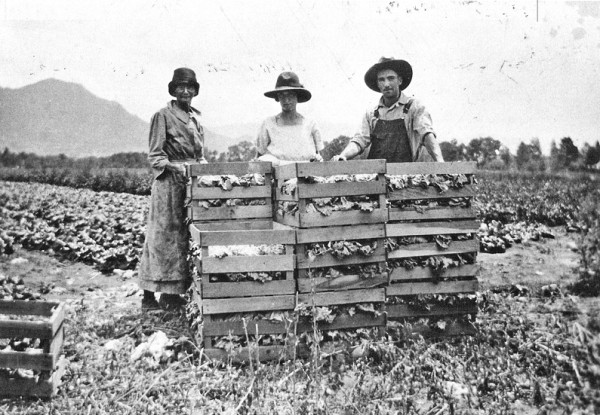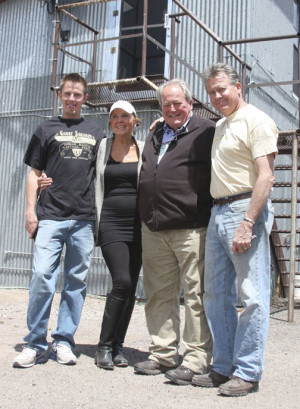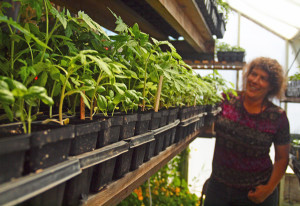Central Colorado and the entire state once had a booming head lettuce growing operation from the early 1920s into the 1940s that is now all but forgotten. With good rail access via the Denver & Rio Grande to eastern markets, favorable growing conditions and plenty of ice to chill the leafy vegetable, head lettuce production was all the rage.
However, changing market conditions and the introduction of the refrigerated rail car doomed the local industry. Growing head lettuce in Colorado followed a national trend of the time where agriculture was expanding, and growers were taking chances with crops that ultimately didn’t grow well in certain locations.

Pictured are Martha Mahon, her daughter Cassie and Cassie’s husband George Fields with crates of head lettuce. Courtesy of Buena Vista Heritage Museum.
For Colorado, the lettuce growing industry collapsed in places like Middle Park, eastern Routt County, Eagle County, the Wet Mountain Valley and in Central Colorado. Last year, the state harvested about 115,000 acres of head lettuce, down from nearly 200,000 acres in 1998. That’s substantially more than was ever grown locally, but in an era when fresh vegetables were becoming more affordable and easier to access, what transpired in the local head lettuce industry was truly historic.
Growing head lettuce in the Buena Vista area began in 1919 when G.D. Isabell made a survey of land along the D&RG Railroad. He found the altitude favorable, the soil desirable and irrigation plentiful. On S.E. Burleson’s ranch just west of town, Isabell planted 10 acres. The large compact heads were supposedly better than the quality of the California head lettuce, and an industry was born.
According to Buena Vista newspaper reports, by 1920 the industry was expected to ship 60 rail cars of head lettuce.
In 1921, the Colorado Cooperative Lettuce Growers Association organized giving growers in the state a powerful marketing tool. Locally, the Buena Vista Lettuce Growers Association was said to receive, grade, pack and load the produce but not sell it. Sales were handled by the American Fruit Growers, Inc. The association label was “Bear Brand” and the fruit group was “Blue Goose.” Buena Vista even had a special name for its lettuce: “Buena Kist.”
By 1922 the Salida growing district was making plans to get in on the lettuce boom with more than 40 people becoming members of the Colorado Cooperative Lettuce Association in the town. Headquarters for the association was in the Unger store and Sid Burleson was a leader, The Salida Mail reported.
That same year there were about 1,500 acres of lettuce being grown in Buena Vista. Westcliffe had 800 acres, the Hardscrabble district 400 acres, the Divide district 300 acres and the San Luis district 500. It was reported in the Chaffee County Republican that Buena Vista shipped 163 cars in 1922, followed by Florence with 85, the Yampa district with 75 and Avon with 73.
Around Westcliffe, the San Isabel Produce Growers Association was formed, and in the Hillside area, farmers tried planting the vegetable and used nearby ponds to harvest ice. At Buena Vista, Ice Lake west of town was a major source, and at Pando, the railroad annually harvested about 40,000 tons of ice.
An advertisement in the Sept.1, 1922 Fairplay Flume extended an invitation to the first annual Head Lettuce Celebration on Sept. 3-4 in Buena Vista. The event would feature baseball tournaments, horse racing, free barbecued beef, hot rolls and coffee in Buena Vista’s park. Over the years, Lettuce Days also featured a farm, garden and fruit exhibition, along with airplane stunts and other attractions.
Lettuce Days went on to run until the 1940s, when it eventually morphed into the Collegiate Peaks Rodeo. During a number of the Lettuce Days events, the Ku Klux Klan held “gigantic” parades, such as in 1925, when 200 Klan members marched with burning crosses, and people arrived days, early filling hotels, campgrounds and private rooms.
During harvest, lettuce was cut from the field and trucked to a loading platform, where it was packed two dozen heads per crate and covered with ice. With ice filling the bunkers of the railcars, and with renewal along the way, Colorado lettuce was arriving at eastern destinations firm and crisp.
Returns were high, possibly as high as $500 an acre. “Why should not our higher altitude meet these market calls for choice vegetable in the populous east?” asked the Chaffee County Republican. The paper went on to wonder who would “get going” with asparagus, cauliflower and commercial cut flowers, noting that the west coast was shipping trainloads of vegetables right through the area, “raking the well earned profits of the enterprise.”
In late September of 1923, the crop was coming in strong; and the packing plant in Buena Vista was running two shifts and sending out four cars every 24 hours. The price was $2 per crate. Three hundred crates would fill a railroad car.
In 1925, the Buena Vista Lettuce Association started shipping on July 28 and finished on Oct. 28. They shipped 10,000 crates of lettuce, 11,000 crates of peas and 7,000 “pony” crates of cauliflower.
In 1927, the lettuce sheds operated by Monarch Ice & Produce Company around Salida were employing 30 men in two shifts. The enterprise was owned by Frank Mansheim and shipped 21,000 crates of lettuce alone.
According to the Salida Record, that year the Salida crop averaged $400 an acre, and the local growers like Pete Veltri, the Martellaros, George Everett, the Cowen Brothers and others were getting their lettuce to market earlier than other locations, thanks to Salida’s lower elevation. Prime growing spots were just adjacent to the South Arkansas River.
By 1929, the farms along the D&RG were growing 10,420 acres. Around Buena Vista it was 1,400 acres, with approximately 200 acres in and around Cotopaxi and the Wet Mountain Valley. In the San Luis Valley it was more than 4,000 acres.
However, in 1934 the fall crop of head lettuce around Salida, Nathrop and Buena Vista was only at about 5,000 crates although the quality was reported as superior to that of several past seasons. Growers were netting about $1.50 to $2 a crate. Changing economic conditions were beginning to take hold upon the industry, and with a war on the horizon, the realities of head lettuce growing in Central Colorado were beginning to set in.
Christopher Kolomitz is a small business owner and freelance journalist living in Salida. He likes his head lettuce with bacon, tomatoes and blue cheese crumbles.





